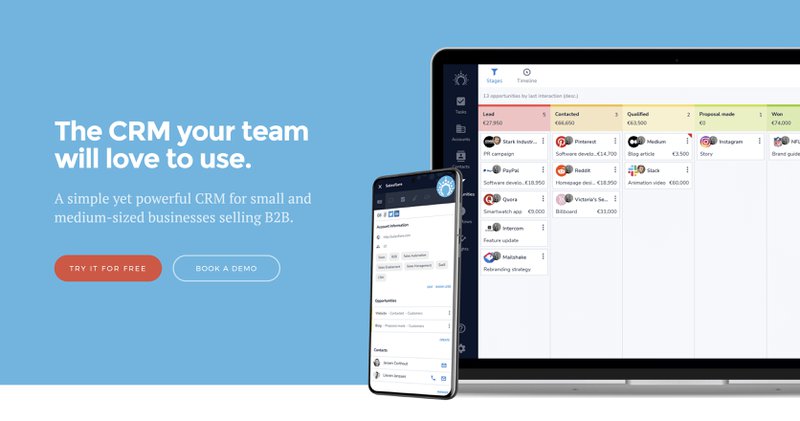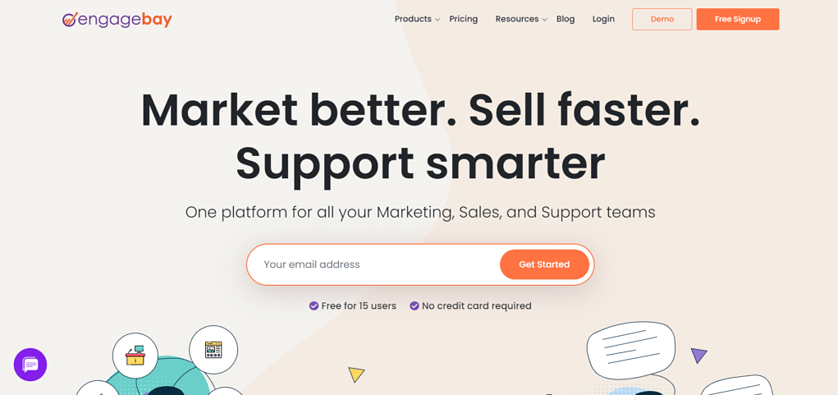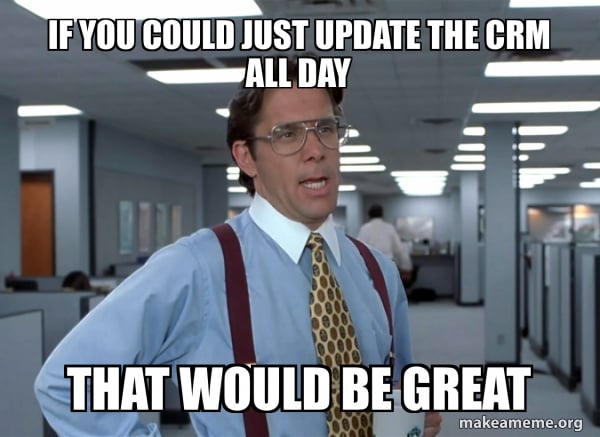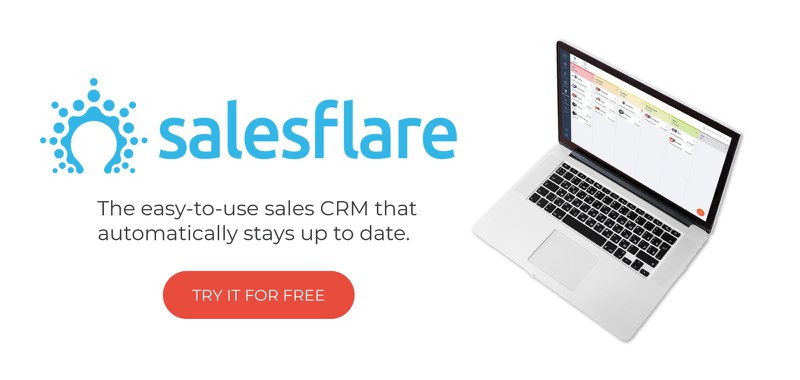8 Best Small Business CRMs in 2024
and how to pick the one that’s best for you
Looking for the best CRM for your small business?
We’ll discuss some of the top choices without confusing you with lots of details about features. 😖 Instead, we’ll clearly explain when to pick which CRM. 😁
Plus we’ll summarize the different review scores to highlight what fellow small businesses think.
Here’s what we’ll cover in short: 👇
- How you can define what the best CRM is for your small business
- The 8 best CRMs for small businesses ranked
- Which of these CRMs to pick in which case
- Why the best CRM is the one your sales team uses
- 3 steps to CRM success
How can you define what the best CRM is for your small business?
There are a three questions to consider when choosing a great small business CRM:
- Does it work for your use case and business?
- Does it fit with the rest of your sales toolset?
- Is it a good CRM?
To answer question 1, start from your exact use case and your type of business:
- Are you a small or medium-sized business (SMB) actively selling B2B? Salesflare will be best for you.
- Are you in real estate instead? Check out our review of Propertybase in this article.
- Are you in another type of B2C business and need something for sales? Have a look at Pipedrive or Freshworks CRM. (Or you can also check out these full lists of the best sales CRMs and best lead tracking software.)
- Are you an SMB but more focused on marketing automation? Have a look at HubSpot, ActiveCampaign or EngageBay.
- You want something that can do literally everything and is not built for anything in particular? Sounds like Zoho CRM Plus.
- Are you working for a company with 200+ employees? You’ll probably need an enterprise CRM like Salesforce. Also… why did you Google this? 😁
To answer question 2, consider whether the CRMs you are looking at are a great fit for your sales toolset. We have dedicated breakdowns for the following:
And finally, for question 3, you can look for CRMs that are well rated by their users across platforms. For this, check out the CRMs in this list and their global review ratings.
These global review ratings are obtained by combining three ratings into one:
- Product rating, from the #1 B2B software review site (G2)
- Mobile app rating, from the #1 mobile app store (Google Play)
- Email plugin rating, from the #1 email plugin marketplace (Google Workspace Marketplace)
That way you know you get a small business CRM that performs on all fronts. ⭐⭐⭐⭐⭐
The 8 best CRMs for small businesses ranked
Don’t want to read the whole comparison? 🤓
Here’s a quick overview of how each CRM performs:
- Salesflare: 9.7/10 🏆
- Salesforce: 8.7/10
- HubSpot CRM & Sales Hub: 8.6/10
- EngageBay CRM & Sales Bay: 8.6/10
- ActiveCampaign: 8.5/10
- Freshworks CRM: 8.3/10
- Zoho CRM Plus: 7.7/10
- Pipedrive: 6.6/10
Want to dig into the details? Read on! 👇
1. Salesflare [9.7/10] 🏆

If you’re a small or medium-sized B2B business and need something that your team will actually use, Salesflare may be right for you.
Salesflare is a dedicated sales CRM that was built from the ground up to help your sales team build better relationships and sell more, while requiring very little of that dreaded data input.
It’s made to pull all the data together from where it already is (your Office 365 or Google email, calendar, phone, social media, company databases, email signatures, email & web tracking, …) and uses that to help you follow up your leads in a better way.
The flip side is that some companies are not used to sharing this much information within the team, although this has been changing dramatically in recent years, and Salesflare has introduced a new permissions system for companies who want to limit some of that newly created transparency.
Salesflare’s G2 review scoring:
- Ease of Use: 9.5
- Ease of Setup: 9.5
- Meets Requirements: 9.3
- Quality of Support: 9.7
- Ease of Doing Business With: 9.9
- Ease of Admin: 9.5
Salesflare’s review ratings:
- Product (G2): 9.6/10
- Mobile app (Google Play): 4.8/5 → 9.6/10
- Email plugin (Google Workspace): 5/5 → 10/10
- FINAL REVIEW SCORE: 9.7/10
Price of the Pro plan:
- $49/user/month (billed annually)
- $55/user/month (billed monthly)
If you don’t sell B2B (aka to other businesses) and don’t do active sales, one of the below CRMs might then be a better fit for you. But, if you do actively sell B2B, give Salesflare a try.
It only takes a few minutes to start a Salesflare trial and follow up your leads in a better way.👈
We guarantee you won’t find any better CRM for your small business! 👌

2. Salesforce [8.7/10]

Salesforce is the biggest CRM company in the world, controlling about 20% of the market. Its stock ticker is even “CRM”, so we definitely can’t compile a list of CRMs without mentioning it.
While, in the first few years of its existence, Salesforce was focused on small businesses, it has since shifted its focus on enterprises. This also immediately explains why it’s forte is extreme customizability (provided you pay a team of consultants to do that) and why it has positioned itself to be the one software vendor that offers a solution to all your business needs.
Salesforce does still offer a solution to small businesses today, called Salesforce Essentials, a limited version of the full platform. Compared to other CRMs in this list however, it lacks in user friendliness and is not really customized for sales teams.
This frustration with Salesforce is actually one of the reasons why we started building Salesflare, and – perhaps not surprisingly – why many of our customers find Salesflare while looking for a better alternative.
If extreme customizability is however your thing, or you’re working at a corporate, Salesforce might still be the best choice for you. But before signing any contract, read this guide to the small print first.
Salesforce’s G2 review scoring:
- Ease of Use: 8.1
- Ease of Setup: 7.5
- Meets Requirements: 8.8
- Quality of Support: 8.2
- Ease of Doing Business With: 8.3
- Ease of Admin: 8.0
Salesforce’s review ratings:
- Product (G2): 8.2/10
- Mobile app (Google Play): 4.2/5 → 8.4/10
- Email plugin (Google Workspace): 4.7/5 → 9.4/10
- FINAL REVIEW SCORE: 8.7/10
Price of the Pro plan:
- $75/user/month (only billed annually)
3. HubSpot CRM & Sales Hub [8.6/10]

HubSpot is a marketing automation platform turned everything platform. It was founded in 2005 to make marketing automation easier.
Nowadays, HubSpot’s main selling point is offering an all-in-one solution, including marketing, sales, service and operations. If you don’t like using different apps and integrating them (using tools like Zapier and native integrations), then HubSpot might be what you’re looking for.
The flip side of the coin is that HubSpot’s software is extremely expensive. Yes, it’s small business CRM is free, but it’s only comparable to the others in this list if you buy it together with the Sales Hub. And if you want to actually reap the benefits of the all-in-one platform, you need to pay up for the other Hubs too.
On top of that, you’ll find that the different tools in the platform do not compare to their more polished, feature-rich and usually cheaper competitors.
Actually, if you have some ideas of what functionality you need (a CRM, lead forms, landing pages, automated emails or maybe newsletters, …), hit us up on the chat and we’ll help you come up with the perfect sales-marketing stack. I guarantee that it’ll be better and cheaper… and easy to integrate.
HubSpot’s G2 review scoring:
- Ease of Use: 8.6
- Ease of Setup: 8.3
- Meets Requirements: 8.5
- Quality of Support: 8.5
- Ease of Doing Business With: 8.7
- Ease of Admin: 8.6
HubSpot’s review ratings:
- Product (G2): 8.5/10
- Mobile app (Google Play): 4.6/5 → 9.2/10
- Email plugin (Google Workspace): 4.0/5 → 8.0/10
- FINAL REVIEW SCORE: 8.6/10
Price of the Pro plan:
- $90/user/month (billed annually – minimum 5 users)
- $100/user/month (billed monthly – minimum 5 users)
4. EngageBay CRM & Sales Bay [8.6/10]

EngageBay is the newest CRM in this list, founded in 2017.
It’s an all-in-one CRM, spanning everything from CRM to marketing and sales, so you could call it a younger HubSpot. The company even uses the same way to structure its products, with a free CRM at the center and a series of “bays” around it (like the “hubs” of HubSpot”).
The biggest pro of EngageBay is exactly that: you can get everything (and it’s a lot of functionality) in one place.
The free CRM itself of course does not come with a lot of functionality, so if you want something comparable to other CRMs in this list, you’ll quickly find yourself upgrading to the paid plans. In that respect, the pricing also becomes quite comparable to most other products in this list (except of course for the significantly higher priced HubSpot and Salesforce products).
The flip side of the coin here is that the interface is not the prettiest nor the smoothest and that some things do feel a little buggy, but it’s a young and relatively cheap product that has built a lot of features, so this is definitely not abnormal or surprising.
All in all, EngageBay’s ratings on G2 and Google Play make it land in third place in this ranking. (It does not have an email plugin available in the Google Workspace marketplace, so we counted an average 3.9 rating into the score to avoid throwing off the ratings.)
EngageBay’s review scoring:
- Ease of Use: 9.2
- Ease of Setup: 9.1
- Meets Requirements: 9.3
- Quality of Support: 9.5
- Ease of Doing Business With: 9.1
- Ease of Admin: 9.2
EngageBay’s review ratings:
- Product (G2): 9.2/10
- Mobile app (Google Play): 4.3/5 → 8.6/10
- Email plugin (Google Workspace): none → average rating of 3.9/5 → 7.8/10
- FINAL REVIEW SCORE: 8.6/10
Price of the Pro plan:
- $79.99/user/month (billed monthly)
- $73.99/user/month (billed annually)
- $67.99/user/month (billed bi-annually!)
5. ActiveCampaign [8.5/10]

ActiveCampaign is an email marketing/automation platform, founded in 2003. It now brands itself as a customer experience automation (CXA) platform, to cover its expanding range of functionality.
ActiveCampaign added a small business CRM to its offering in 2014, as a sales focused add-on to the rest of the platform. This integration between email automation and CRM is probably its main forte.
Setting up ActiveCampaign is not a light task and its software may become overwhelming, while the CRM aspect itself on the other hand will not be as feature rich compared to the other CRMs in this list.
When people compare ActiveCampaign to Salesflare, which also offers automated emails and email sequences, our advice is usually simple: if you’re an ecommerce company or B2C company, or you need very complex or very high volume email automation, ActiveCampaign is probably what you’re looking for. If you’re a B2B company with an active sales team and the need to automate more personal emails, then go with Salesflare.
ActiveCampaign’s G2 review scoring:
- Ease of Use: 8.7
- Ease of Setup: 8.5
- Meets Requirements: 9.1
- Quality of Support: 9.1
- Ease of Doing Business With: 9.2
- Ease of Admin: 8.7
ActiveCampaign’s review ratings:
- Product (G2): 8.9/10
- Mobile app (Google Play): 4.3/5 → 8.6/10
- Email plugin (Google Workspace): 4.0/5 → 8.0/10
- FINAL REVIEW SCORE: 8.5/10
Price of the Pro plan:
- $149/month (billed annually, with max. 2500 contacts)
- $187/month (billed monthly, with max. 2500 contacts)
6. Freshworks CRM [8.3/10]

Freshworks CRM is a sales CRM from Freshworks, the company behind / initially called Freshdesk. Freshworks was founded in 2010 to provide a better, cheaper solution for customer service teams.
Freshworks’ main selling point is its feature depth. It has also managed to offer this range of functionality through an easier to use interface than its competitors/predecessors from the same city (Chennai, India), Zoho.
The flip side here is that the software does feel quite bulky and that the functionality feels like its built too fast to be really well thought through. If complex software frustrates you, it probably isn’t for you.
If you’re in for its most basic plan, the price-functionality ratio is comparable to the more normally priced small business CRMs in this list. The pricing however ramps up very quickly from there as you need more functionality (or more than 1 pipeline, 5 sequences, …).
Salesflare doesn’t often get compared to Freshworks CRM, but when it happens, it’s people weighing getting something that their team will love to use, against something that checks off a few more of the boxes on their specs list.
Freshworks CRM’s G2 review scoring:
- Ease of Use: 9.1
- Ease of Setup: 8.9
- Meets Requirements: 8.9
- Quality of Support: 9.0
- Ease of Doing Business With: 9.1
- Ease of Admin: 9.4
Freshworks CRM’s review ratings:
- Product (G2): 9.0/10
- Mobile app (Google Play): 3.8/5 → 7.6/10
- Email plugin (Google Workspace): 4.2/5 → 8.4/10
- FINAL REVIEW SCORE: 8.3/10
Price of the Pro plan:
- $39/user/month (billed annually)
- $47/user/month (billed monthly)
7. Zoho CRM Plus [7.7/10]

Zoho Corporation is a software development company, founded in 1996 (coincidentally in the same city as Freshworks above), which is behind an extremely wide range of software products.
It launched a small business CRM product in 2005, which has historically been positioning itself as a cheaper alternative to Salesforce. And that’s immediately its biggest strength.
The pinnacle of its offering is Zoho One, which gives you access to 40+ of its “business apps” for $105/user/month (or $45 if you get it for ALL your employees). Talk about cheap!
The flip side is that Zoho’s products don’t feel user friendly. While the engineering team does churn out a lot features for a low price, the user experience is generally lacking.
Still, if you can’t resist a good deal, Zoho has a whole lot to offer you. Or, if you’ve already tried Zoho and didn’t love it, give Salesflare a try.
Zoho CRM’s review scoring:
- Ease of Use: 8.1
- Ease of Setup: 7.6
- Meets Requirements: 8.2
- Quality of Support: 7.4
- Ease of Doing Business With: 7.9
- Ease of Admin: 7.8
Zoho CRM’s review ratings:
- Product (G2): 7.8/10
- Mobile app (Google Play): 4.2/5 → 8.4/10
- Email plugin (Google Workspace): 3.5/5 → 7.0/10
- FINAL REVIEW SCORE: 7.7/10
Price of the Pro plan:
- $57/user/month (billed annually)
- $69/user/month (billed monthly)
8. Pipedrive [6.6/10]

Pipedrive is a dedicated sales CRM. It was founded in 2011 in Estonia as a counterreaction to enterprise CRMs like Salesforce, which are built more for enterprise needs than they are for managing sales teams.
Pipedrive’s power is its simple and well considered user experience, especially when it comes to its older functionality. It makes data input and keeping track of activities easier, albeit still very manual.
Its main weakness is that it has become a bit stale, with a more limited mobile app, lacking basic automation (e.g. of data input), a wonky email integration, and a set of more recent functionality that is not as thoughtfully built anymore.
At some point in time, we positioned Salesflare as “Pipedrive without the typing” (check this TechCrunch video for instance). We did this because like Salesflare, Pipedrive is built for sales teams, is easy to use, and easy to set up.
The main difference is that, unlike Pipedrive, Salesflare was built from the ground up to automate your team’s data input, which also makes it easy to keep it alive / up to date… so you can reap all the benefits you’d expect to get from a CRM. Because, after all, a CRM is only useful if you keep using it.
Pipedrive’s G2 review scoring:
- Ease of Use: 8.9
- Ease of Setup: 8.7
- Meets Requirements: 8.4
- Quality of Support: 8.4
- Ease of Doing Business With: 8.7
- Ease of Admin: 8.6
Pipedrive’s review ratings:
- Product (G2): 8.6/10
- Mobile app (Google Play): 3.3/5 → 6.6/10
- Email plugin (Google Workspace): 2.3/5 → 4.6/10
- FINAL REVIEW SCORE: 6.6/10
Price of the Pro plan:
- $49.90/user/month (billed annually)
- $59.90/user/month (billed monthly)
Which of these CRMs to pick in which case?
Here’s a quick summary on pros and cons:
- Salesflare [9.7/10] 🏆: your team will actually use it (but the transparency created may be too high for some teams)
- Salesforce [8.7/10]: you’ll be able to customize everything (but it won’t be made for small businesses and for sales teams)
- HubSpot CRM & Sales Hub [8.6/10]: you’ll have everything in one place (but it’ll get extremely expensive for a suite of tools that is not on par with what you get when you buy the specialized tools separately)
- EngageBay CRM & Sales Bay [8.6/10]: you’ll have everything in one place for little money (but what you pay is also what you get)
- ActiveCampaign [8.5/10]: you’ll get advanced email automation (but the CRM part won’t be as developed as with the others in the list)
- Freshworks CRM [8.3/10]: you’ll get a ton of functionality (but it may get a bit bulky and complex)
- Zoho CRM Plus [7.7/10]: you’ll get a lot of functionality for a low price (but it won’t be user friendly)
- Pipedrive [6.6/10]: you’ll get something that is made for sales teams (but that has become a bit stale)
Don’t take our word for it however. We’re very well informed, but also a little biased. 😄
For a longer breakdown with screenshots and testimonials that covers Salesforce, Zoho, HubSpot, Pipedrive and Salesflare, check out this ultimate comparison.
And know that, in the end, your priorities will define what’s the best choice for YOU.
Still, before we leave you with some practical advice on how to pick and implement the right one, let us share with you why we believe the best small business CRM is the one your sales team actually uses.
Why the best CRM is the one your sales team uses
A study by CSO Insights reveals that 43% of CRM customers use fewer than half of the features of their CRM.
Another startling statistic from a Staples Workplace study is that 70% of staff say poorly performing technology is a drain on productivity rates; the most important factor, ahead of burn-out, illness and office politics. 😣
And it’s not just about not using certain features, or seriously hurt productivity, it’s about much more. A CRM that isn’t properly used by the sales team causes a long series of very serious issues:
- When somebody leaves, you have to start building a lot of customer relationships again from scratch
- When somebody is sick, it’s very hard to replace them
- Coaching your sales team and helping them do better is very hard, as you have very little to base yourself on
- Creating up-to-date revenue forecasts requires a lot of work/nagging
- Collaborating within the sales team or between the sales and marketing teams is 10x harder
- …
That’s why, according to CSO Insights, 72% of senior executives would trade more ease of use for less functionality, and, according to Inside CRM, 65% of sales professionals find ease of use the most important CRM feature. ✨
In conclusion, if your sales team doesn’t use the CRM, it’s not very useful to have one.

Now, how do you make sure you pick and implement a CRM so they WILL use it? 👇
3 steps to CRM success
Based on many years of helping customers be successful, here’s our 3-step advice to pick the right CRM for your business and implement it the right way:
- Figure out what you need a CRM for. Many businesses will just type “CRM” into Google. What they’ll typically end up with is one of the 650+ CRMs that has the deepest pockets, which gets it visibility at the top of search and review listings, not the one that is best for them. If you’re in real estate, you’ll need something else than when you’re in ecommerce, or when you have a nail salon, or when you’re in B2B sales.
- Involve your sales team in the decision. Don’t choose a CRM by yourself and impose it on your sales team. Chances are high they won’t use it, which will render the CRM useless. Instead, make a shortlist and get them to actually use those CRMs. If they see themselves using the CRM, you’re way more likely they’ll start and keep using it. Plus, you have their buy-in.
- Train the team on what it does and HOW you’ll use it as a team. Training the team on what the CRM can do is essential, so your team can use it to its fullest potential. Still, you’re setting yourself up for failure if you don’t also decide how you’re going to use it as a team. If everybody uses the system differently, it’s hard to collaborate or make sense of the data. Take a few moments to come up with some guidelines, and you’ll have again maximized your chances for success.
If you follow all 3 steps, you’re immediately ahead of 99% of other small businesses, as our experience tells us they all seem to skip at least one of them! 🥇
Want more guidance? Let us know! Our team is here to help. Even if you don’t end up picking Salesflare.

We hope you liked this post. If you did, spread the word!
👉 You can follow @salesflare on Twitter, Facebook and LinkedIn.
- 8 Benefits of CRM + 6 Challenges to Overcome First - April 18, 2024
- 8 Best Sales Management Software + Feature Comparison [2024] - March 28, 2024
- 20+ Best B2B Lead Generation Companies & Services [by Category] - March 21, 2024

